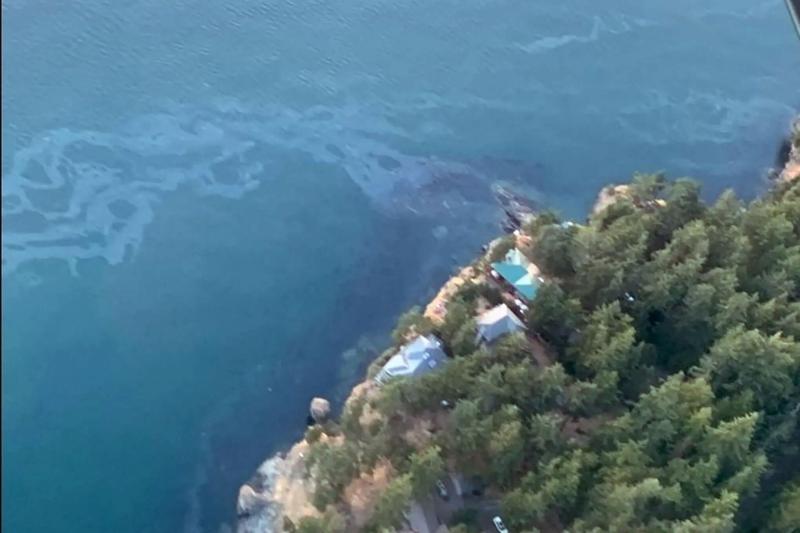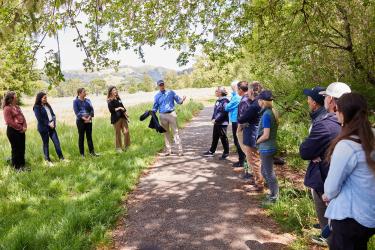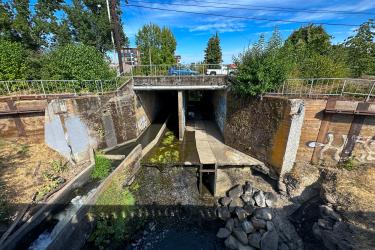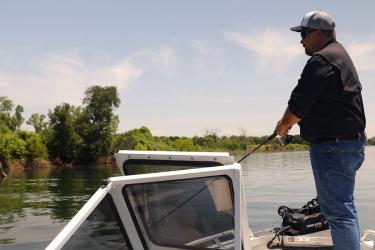What do you do when endangered Southern Resident killer whales are headed toward an oil spill?
That was the question NOAA Fisheries, along with federal, state, and local partners, wrestled with this summer. Endangered killer whales were spotted in the Strait of Juan de Fuca headed toward the San Juan Islands, where a fishing vessel had gone down and was leaking fuel. After determining that the crew was safe, the oil spill response team focused on protecting the environment, the iconic Southern Resident killer whales, and other precious resources.
Within hours of the vessel sinking, NOAA Fisheries partnered with the Washington Department of Fish and Wildlife (WDFW) and Fisheries and Oceans Canada (DFO). These and many volunteer organizations put the oil spill response plan for killer whales into action. At the same time, other responders focused on other environmental impacts and on raising and removing the leaking vessel. However, implementing the response plans in real-world conditions never goes exactly as expected.
The F/V Aleutian Isle Sinks and Releases Oil into Sensitive Environment
On August 13, 2022, the 58-foot fishing vessel Aleutian Isle sank near Sunset Point on San Juan Island in an area roughly 100 feet deep. There was an estimated 2,600 gallons of diesel and oil onboard. By the next day, an oil sheen from the vessel could be seen across a two-mile area.
Following the plans for such an incident, a Unified Command was quickly set up. It included:
- U.S. Coast Guard
- Washington Department of Ecology
- San Juan County Office of Emergency Management
- Swinomish Tribe
The larger Incident Command involved support agencies with tailored expertise, including:
- NOAA Fisheries
- NOAA Office of Response and Restoration
- Washington Department of Fish and Wildlife
- Islands’ Oil Spill Association
- U.S. Fish and Wildlife Service
This group, with many other national and Canadian partners, worked together through a Wildlife Branch to protect the sensitive wildlife in the area and remove the sunken vessel.
The vessel could not have sunk in a worse location. With deep waters and roaring currents, the west side of San Juan Island is an important feeding area for endangered Southern Resident killer whales. It is also critical habitat for the endangered bocaccio rockfish and threatened yelloweye rockfish. The area is also used by humpback whales, minke whales, and harbor seals, which are all present throughout the summer months.
Response Requires Trained Divers
The currents and steep bathymetry off of San Juan Island are complex. The team needed specialized divers to assess the vessel's status on the seafloor and develop a plan for its removal. Once these crews arrived on August 15, they discovered that the vessel had slipped from the original depth of 100 feet to a depth of greater than 200 feet. This new extreme depth was at the boundary of where divers could safely operate. It required more specialized equipment and training, and a more complicated salvage recovery plan. The National Ocean Service along with NOAA's Center for Operational Oceanographic Products and Services worked closely with the dive team at Global Diving and Salvage to model the currents and tides in the area to ensure divers stayed safe while attempting the complicated dives.
“The strong currents off San Juan Island made it difficult for the divers to figure out when it was safe to go down and work on recovering the vessel. We worked with contractors that had specialized equipment on-site to find the small slack tide windows that were safe for these operations,” said Commander Faith Knighton, a Scientific Support Coordinator for the Northwest OR&R in the Emergency Response Division. “It took some time to get our models synced with the equipment measuring on-site currents, but we were able to create a forecast to predict the slack current windows safest for in-water operations and provide them with the scientific support they needed.”
During dive operations, small pockets of diesel and oil were released to the surface. These areas of sheening were monitored by manned aircraft and unmanned aerial overflights using drones with on-water observers.
“The use of drones to monitor oil sheening and track whales has been crucial during other oil spill responses in British Columbia. We were happy to work with the Wildlife Branch and provide drone support so the team could determine the best approach for the whales in real time,” said Paul Cottrell from the Marine Mammal Response Unit for DFO.
In addition to oil seeping from the vessel, hundreds of feet of purse seine fishing nets extended out from the vessel and floated at the surface. These nets posed a risk of entanglement to the many marine species that move through this productive area and the divers working on the sunken F/V Aleutian Isle.
NOAA worked with the USCG, Washington Department of Ecology, and other agencies to remove approximately 1,400 feet of netting from the surface on August 17. The Marine Debris Program guided the lifting of the heavy nets out of the water without damaging the sensitive seafloor. Divers continued to remove netting from the seafloor and attached to the F/V Aleutian Isle until the vessel was lifted to the surface. Because of this quick action and attention, no marine mammals or other sensitive species were entangled.
A Coordinated Response to Monitor and Protect Marine Mammals
The Unified Command identified the protection of the Southern Resident killer whales as one of the top priorities for the incident from the beginning of the response. The Wildlife Branch quickly established two components for marine mammal management: real-time monitoring of marine mammal sightings and a Whale Deterrence Team.
The Wildlife Branch worked with the Orca Network, the Whale Museum, SMRU Consulting, the Pacific Whale Watch Association, and DFO on the real-time monitoring of species. They collected sightings of marine mammals near the San Juan Islands, particularly Southern Resident killer whales. This allowed teams to monitor the potential for exposure and try to prevent killer whales from swimming through areas with oil sheening. A network of hydrophones in the United States and Canada also provided critical information for tracking the movement of the whales through the Salish Sea. This gave the Wildlife Branch advance notice on when the whales might reach the incident area.
"Our skilled captains and naturalists provided real-time whale reports to the Unified Command throughout each day including species, direction of travel, and number of individuals present," said Erin Gless, Executive Director of the Pacific Whale Watch Association. "We're pleased we were able to assist in minimizing threats to local wildlife while crews worked to safely recover the Aleutian Isle."
The Wildlife Branch reported the sightings to all responders every 2 hours to keep the whole team aware of marine mammals in the area. When killer whales were approaching the spill, the Wildlife Branch quickly convened to determine whether to attempt deterrence efforts to keep the whales away from areas with oil. They assessed how soon the whales would arrive on scene and worked with the USCG to determine the current oil exposure risk.
Local Experts Provide Guidance
Local killer whale researchers and experts familiar with the animals and their behaviors made up the Whale Deterrence Team. Dr. Brad Hanson from the Northwest Fisheries Science Center led this team, with Paul Cottrell from DFO as a co-lead. The Whale Deterrence Team was comprised of experts from non-profits, including Wild Orca, Soundwatch, San Juan County Marine Mammal Stranding Network, SeaDoc Society, government agencies, including Washington Department of Fish and Wildlife and the Marine Mammal Rescue unit from the DFO, and marine mammal expert Jeff Foster.
The Wildlife Branch maintained deterrence team vessels on a 2-hour standby throughout the day in order to be able to respond to marine mammals that might move into the incident zone. Each crew was given an oikomi pipe. These are long metal pipes that are partially lowered into the water and struck with hammers. The response team can use the sound they produce to direct killer whales away from areas with oil.
“We organized two drills where each boat practiced using the oikomi pipes individually and as a group. My boat acted as a whale, and the others had to work together as a united front to redirect me away from an area by maneuvering as a unit while continuing to strike their pipes,” said Dr. Hanson. “I appreciate the time and effort the team put into protecting the whales, especially the Southern Residents. It was great that many of the local killer whale experts were involved in the response, and we now have a strong team of people trained and ready if there is ever a future spill.”
The Whale Deterrence Team was on standby for more than a month. It was activated on several days when it appeared that killer whales were headed toward an area with visible sheen. Deterrents were used on two male transient killer whales on September 18 and 20. The deployment on September 18 included biologists from the Northwest Fisheries Science Center, SeaDoc Society, and DFO. DFO was able to collect drone footage of the deployment. The Northwest Fisheries Science Center, SeaDoc Society, and Wild Orca were involved in the deployment on the September 20.
With both uses of the oikomi pipes, the whales made deep dives in response to the pipe banging, but soon resumed their swimming along the island and away from the oil. Teams monitored the whales until they had moved away from the areas of risk.
Oil Spill Response Plan Put into Practice
Fortunately, the Wildlife Branch activated during the spill had a solid plan to guide the response.
The recovery plan for Southern Resident killer whale identified an oil spill response plan as a key action. A 2007 workshop developed a report reviewing various tools to deter killer whales from an oiled area.
Lynne Barre, NOAA’s Southern Resident killer whale recovery coordinator, remembers that original workshop. “That original workshop gave us some idea of what tools we could use to keep the Southern Residents away from an oil spill and helped me sleep better at night. We are still learning how harmful oil exposure can be to marine mammals, and we want to be ready.”
Based on the workshop report, a killer whale response plan was incorporated into the Northwest Area Contingency Plan. Several deterrence methods were pre-approved under Endangered Species Act and Marine Mammal Protection Act permits so they could be deployed quickly in an emergency.
Don Noviello, who works for WDFW and was the Wildlife Branch Director for the F/V Aleutian Isle response, said that these preparations helped with this incident. "We've held a couple of drills over the last several years that helped us be ready for a situation like this," he said, "and based on the vulnerability of the Southern Residents we already had built several oikomi pipes and fortunately had some staged in the San Juan Islands and were able to distribute the pipes to early responders within the first 24 hours in case the whales came by.”
NOAA Fisheries has designated Southern Resident killer whales as one of nine national Species in the Spotlight, imperiled species that need focused efforts to avoid extinction. An Action Plan for the next 5 years includes studies to inform emergency response.
Working with Islands’ Oil Spill Association and WDFW, NOAA participated in two drills in the San Juan Islands to test oikomi pipes, including recording the pipes with underwater hydrophones to understand their sound profile better. The sounds of hovering helicopters were also recorded to better understand how they are received by the South Residents. With each piece of new information, the response plans have been updated to ensure the safety of the responders and the killer whales.
Lessons Learned From F/V Aleutian Isle Removal
After weeks of diving to prepare the vessel for recovery, the F/V Aleutian Isle was lifted to the surface on September 17, more than a month after it sank.
Booms were in place to help contain the sheen from fuel dislodged in the operations. Crews worked to partially drain the vessel and removed approximately 775 gallons of an oily-water mixture. However, they could not access all areas to completely dewater and safely lift the vessel onto the waiting barge that day. Instead, the F/V Aleutian Isle was connected to the side of the barge and transported to Mitchell Bay.
Once in the shallower waters, the vessel was drained of fuel and water and re-rigged for lifting. Crews removed an additional 300 gallons of oily-water mix and lifted the vessel out of the water and onto the barge on September 21. Following the lift an additional 3,500 gallons of oily water and 590 gallons of diesel were removed. This event was the first Type 2 incident (requiring regional and/or national resources) for the USCG Sector Puget Sound in 15 years.
The Whale Deterrence team was on standby throughout the lifting operations based on the potential for the release of the remaining fuel and oil on board. Fortunately, the whales stayed clear of the area on the lift day, and no acoustic deterrence was performed. The Wildlife Branch released the team after a job well done and captured input on how to improve operations in the future.
“We spend the summers protecting the whales from vessel impacts, so it was a great opportunity to be involved in protecting them from the oil spill. I’m glad our team was able to help monitor their movements and gain valuable experience from deploying the oikomi pipes.“ said Alanna Frayne, the Soundwatch Program Coordinator for the Whale Museum.
The F/V Aleutian Isle response was a reminder that, even with all of the positive efforts to prevent and prepare for spills, the Southern Residents live in an urban environment. They remain at risk. The J, K, and L pods can all gather together as part of their social interactions, forming a superpod. These reunions put the small population at risk of a catastrophic event that could impact all 73 whales at the same time.
We’ve learned much about how fuel and oil exposure can affect marine mammals, particularly the long-term effects of the Deepwater Horizon oil spill in the Gulf of Mexico. In the summer of 2022, the long-standing plans and preparations were a vital backstop to prevent the Southern Residents from exposure to leaking fuel and oil from a sunken fishing vessel.
Training and deploying whale deterrence teams provided new insights into how we can be even better prepared and effective next time. We still have work to do to bring all of the real-time sightings and hydrophone detections together into one seamless stream of whale location data for oil spill response or other protections. We also learned that drones are a critical new tool not just to study the whales, but to identify oiled areas, sheen, and to see how the whales react to deterrence methods.
Although we hope prevention measures avoid another spill, NOAA will continue our collaboration with WDFW, DFO, and other partners to ensure we have trained personnel, equipment in key locations, and an updated plan of action to minimize impacts from any future spill. The many lessons learned and partnerships formed during this incident will ensure that we will be ready with a smooth and timely response if a spill happens again.









